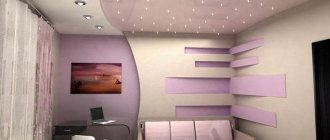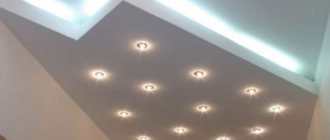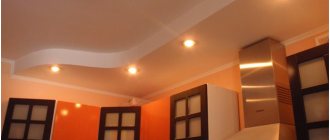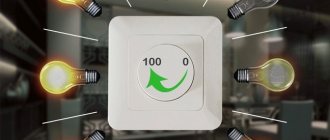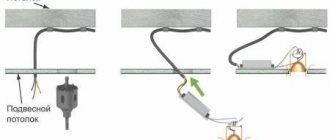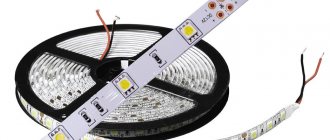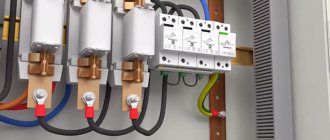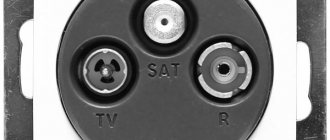The use of point light sources in the home space is justified not only from the point of view of creating better lighting conditions, but also to highlight certain specific features or individual areas of the interior. Therefore, we will analyze what schemes it is possible to connect spotlights with, what these lighting devices are, what their structure is, pros and cons, what types there are and what are their features, what schemes are best to connect, and also what are the specifics of their installation.
Spotlights create more even lighting than a traditional chandelier Source cozzyroom.com
Spotlight - what is it, design, features
A source of artificial lighting is called a point or spot lamp when its connection and installation involves operation in a certain general scheme in conjunction with similar devices within the same working area. For example, a classic chandelier can be installed in the same room. However, the flow of light it creates will be distributed so that some areas will be well lit, while others will remain in the shadows.
Moreover, the farther you are from the light bulb, the more the light intensity will decrease. Point sources, in contrast to this scheme, create a more uniformly directed distribution of light flux - due to the fact that they are located in different parts of the ceiling, and their light fluxes overlap and complement each other. In addition, they differ from conventional lamps in their design, which usually includes the following main elements:
- The housing in which the main working elements are located.
- Fastening - the design depends on the location and method of installation. It can be a built-in, surface-mounted or rotary system.
Built-in spots have special devices for fixing to the finishing material Source katlavan.ru
- Light source – modern models of spotlights can be equipped with incandescent, halogen, fluorescent and LED lamps.
- Optical element - for better focusing or dispersion of the light flux.
- Elements of external decoration.
- Wiring.
Most of the spotlights available on the market today are designed for installation on ceilings or walls, as well as for decorating furniture and interior elements. Installation of such emitters requires the presence of a small free space behind the overhead panel. The cavity houses not only the rear part of the device, but also brackets, wires and other mounting parts.
On a note! The external decorative trim for spot lights is made of plastic, wood or metal. Its main task is to limit the device and decorate. The external shape, size and color are determined by the design of the room and the choice of the installer.
A special decorative overlay creates a special optical effect Source elektrika.expert
Advantages and disadvantages
Like any other types, spot lighting devices have their own specific pros and cons. So, their advantages are mainly manifested in the following:
- Possibility of assembling the circuit both in group and individual versions. This makes it possible to adjust the brightness of the lighting without using special dimmers, and also creates the prerequisite for saving electricity, since it allows you to turn on the light not for the entire room at once, but only in a specific part, for example, in a spacious dining room, only the dining area.
- Formation of a given set of spots at the same time as full lighting and decorative lighting.
- Minimizing losses in illumination when one device burns out. The brightness level in the room will remain virtually unchanged if only 1 of 10 light bulbs burns out.
- When installing recessed spotlights in a suspension system, the useful ceiling height does not change, as happens when hanging a standard chandelier.
Compared to chandeliers, recessed spotlights do not reduce the usable height of the room Source folksland.net
- The spots are quite simply designed and do not contain complex elements, so they are easy to maintain, repair and last a long time.
The disadvantages of spot lights are associated with the need for initial financial costs, as well as the correct selection of parameters when installing in a specific room. Directional lighting can also create shadow areas if fixtures are not properly rated to begin with.
Instructions for installing lamps in suspended ceilings
Necessary materials
For installation work you will need the following materials and devices:
- lamp with clamps;
- electric drive;
- light bulbs (suitable for the existing base);
- terminal blocks or sleeves for fastening conductors;
- insulating tape;
- switch.
Lamps must be of the same type. With this approach, it is easier to carry out installation work and there will be no discrepancies in terms of design. Lamps must have a reflective layer applied to the cone of the bulb.
The power of light sources should not be higher than 40 W. This indicator allows you not to be afraid of overheating and, as a result, destruction of nearby materials. The best choice is halogen or LED bulbs.
It is recommended to pay special attention to the wires. For drywall, two-core VVG-2×1.5 is best suited. In the case of plastic or MDF, the conductors must be coated with fire retardant material. An example suitable for plastic is RKGM.
The terminal blocks will have to be monitored periodically even after installation work is completed. Due to heating, these parts gradually become loose, so the bolts need to be tightened.
Planning
First of all, you need to decide on the installation locations of the lamps. The suspended ceiling has fastener lines with metal profiles. It is necessary to check that they do not pass through areas where lighting fixtures are planned to be installed.
Counting the number of lamps
Each device is capable of illuminating an area of 1.5 to 2.5 square meters. m. It is recommended to purchase lamps with a reserve, based on the minimum area illuminated by them (1.5 sq. m). However, you should not be too zealous, since a large number of lamps makes the ceiling structure heavier.
Note! Modern models are often offered in metal frames. If such devices are installed incorrectly, unevenness may appear on the ceiling.
Marking
If a level is used, marks are first made on the floor. Next, using a laser, the dots are transferred to the ceiling surface.
It is more correct to mark the floor not with a tape measure, but with a template prepared in advance. A piece of plinth or cable duct is suitable as such.
Advice! To avoid damaging the floor, it is recommended to use paper tape.
A certain distance must be maintained from the edge of the hole in the polyvinyl chloride film to the baguette. It should be at least 3 cm.
Wiring in the ceiling
During the installation of a suspended ceiling, the wires are laid out near the planned areas of the holes for the lamps. Experts recommend providing a 10-15 cm loop around the entire perimeter of the ceiling. This will allow you to change the arrangement of the light bulbs if necessary. The photo below shows an example of how to correctly place holes with wires for lamps:
The wiring must be secured with ties, as shown in the following photo:
Making holes
You will need a crown to work with wood. This type of crown is used to drill sockets for switches or wires in furniture pieces. As a result of drilling, you need to get the holes as even as possible. Next, measure the diameter of the protruding part of the lighting device and drill a recess one centimeter smaller than the existing circumference. Thanks to this, it becomes possible to remove the wiring from the visibility zone of the suspended structure.
Varieties
First of all, spot lights are classified according to the method of installation into such varieties as:
- Embedded . The device does not require a housing. It is mounted into a pre-made hole in the finishing material and is completely buried in it. In addition to the socket with a light bulb, their design includes a mount and a decorative frame located on the outside of the ceiling. Additionally, a diffuser or lampshade can be installed outside it.
Recessed spot lamp with an additional external lamp Source nikastroy.ru
See also: Catalog of companies that specialize in electrical work of any complexity
- Invoices . Unlike the above, the decorative part of this variety completely protrudes outside the surface on which it is installed. At the same time, for installation it contains a special clip for mounting on a plane. Therefore, installation does not require empty space behind the finishing coating.
- Hanging . The installation of ceiling lamps of this modification is similar to a classic chandelier. The device is simply suspended on a special mount.
- External . They are analogues of small-sized spotlights for creating directional lighting of a selected area. Mounted on brackets.
Important! In most cases, plastic, canvas, and MDF are used as finishing materials for suspended and suspended ceiling systems. All of them have a high degree of flammability. Therefore, for connections and electrical wiring in such conditions, it is necessary to use high-quality and reliable components, and the installation must be carried out in compliance with the rules of electrical installation work.
Fastening of wiring and lamps must comply with safety rules Source sdelai-lesnicu.ru
Types of light bulbs
The second important characteristic by which spot lighting devices differ is the type of light source. To equip modern models of spot lamps, the following types of light bulbs are used:
- Halogen.
Advantages of devices using halogen lamps:
- Bright intense glow, similar in characteristics to natural light.
- Half the size compared to conventional devices.
- Versatile use - suitable for reading, working, relaxing, etc.
- Environmental Safety.
- Long service life compared to a conventional incandescent lamp.
The disadvantages are associated with rapid damage due to voltage surges and insufficient energy consumption.
- Luminescent.
Advantages of fluorescent models compared to classic light bulbs:
- The best energy saving – savings reach 80%.
- Durability.
- Compactness.
However, it is best to select, install and connect such fluorescent spotlights for lighting and decoration outside residential premises. Because they contain a toxic substance - mercury.
Fluorescent spot lights are best used outside a living space - for example, to illuminate a loggia or balcony Source balkonica.ru
- LED.
Positive characteristics:
- Long service life - several tens of thousands of hours.
- Fire safety – minimum operating heating.
- Maximum luminosity with minimum power.
- Economical.
- Large range of color temperature selection.
- Good resistance to power surges.
- Resistance to humid air.
Negative properties - high cost, possibility of flickering with low quality components.
Helpful information! 12V bulbs are safer and therefore preferable for installation in damp areas, such as the bathroom. However, it must be borne in mind that when switching from a standard 220 V light source to a 12-volt analogue and the need to maintain the same power, the current increases several times. This will require the use of a larger cross-section conductor, which will greatly increase the cost of the system. This can be avoided by choosing very bright, but low-power ice lamps for replacement.
LED lamps are optimal in terms of brightness, durability and energy efficiency Source sdsvet.ru
Operating rules
Linear LED lamps are considered reliable devices, but for them to work flawlessly, install them correctly and then follow the instructions for use.
Installation and operation:
- Installation and dismantling is carried out with the mains power turned off.
- Linear LED devices are connected to a high-quality electrical network without sudden changes and voltage surges. It is recommended to connect LED modules to 220 V through network adapters that have built-in protection.
- Check electrical connections and wiring integrity regularly. The lamp must not be turned on if it is damaged.
- It is prohibited to operate luminaires that have mechanical damage to the casing or protective glass. Before installation, check the integrity of the housing.
Connection diagrams for 220 V
Modern spotlights can be connected directly to a 220 V network - both in series and in parallel. Moreover, each scheme has the following characteristics:
- Sequential.
The easiest connection scheme to implement, requiring a minimum of consumables. Its essence is that the phase is transmitted in order to the lamps from the first to the last, and the zero conductor is connected to the last one.
The scheme has a number of features:
- The number of lamps is limited - as a rule, no more than 5-6 pieces.
- The light bulbs do not shine at full strength.
- If one of the lamps fails, all the others will stop glowing. In this case, to restore the operation of the circuit, you will have to check each spot device.
The advantage of this method is that it allows you to connect a large number of low-power light bulbs without including a step-down transformer in the electrical circuit. For example, this could be a chain of 22 lamps of 10 volts each, which will give a total of 220 V.
Diagram of serial and parallel connection of light bulbs Source svetilov.ru
- Parallel.
The essence of the parallel connection method is that both phase and zero are supplied to each lamp. Therefore, the scheme involves a large consumption of materials. However, thanks to this approach, each light bulb shines at full brightness, and the burnout of one of them will not affect the operation of the others.
If sequential connection of lamps implies only one way of connecting light bulbs - next to each other, then in the case under consideration there are at least two options:
- Trailed.
Initially, from the switchboard, the wires are supplied to the 1st device in the circuit, and then from its output in separate sections the voltage is transmitted to the 2nd, from it to the 3rd, etc. The method is used when there are a lot of participants in the circuit, and conduction for each individual wire is not economically feasible.
The downside is that if one of the lamps fails, the others will also stop working. However, it is easier to detect a failed participant than in the sequential method - it will be the one that is located immediately after the one that is working properly.
Diagram of loop and beam connection of lamps Source elektroznatok.ru
- Radial.
A phase and a zero are supplied separately to each lamp. Therefore, the breakdown of one device does not affect the others. Disadvantages - maximum consumption of conductors and the presence of a large number of connections.
Choosing a frame for a stretch ceiling
Be sure to take into account that for the installation of PVC film and fabric, different components are used for suspended ceilings, which are attached around the perimeter of the room.
In addition, the choice of material is determined by the type of ceiling itself, as well as the configuration of the room and the presence of protruding elements. For PVC films, an aluminum profile is used, which comes in the following types:
- universal, which is used when installing rectilinear structures;
- wall profile-sphere, the use of which is limited to small areas, for example, to create curved elements;
- ceiling, differs in the mounting location and is used in cases where it is necessary to minimize the loss of height;
- The dividing profile is used when additional support for the ceiling is required, and also if the area of the room exceeds 150-200 m2 - in this case it is used for the joints of ceiling elements. Indispensable when creating complex multi-level structures or those made in 3D technology.
To tension a fabric ceiling, it is recommended to use plastic profiles AP and AM, which differ in width: in the first case it is only 10 mm, in the second - 30 mm.
The AM profile is often used when installation of a thermal insulation layer is required.
When cutting the canvas, it is important to take into account that during installation the PVC film stretches by 6-8%, and for a fabric ceiling it is necessary to leave at least 10 cm on each side for fastening in the profile, the method of which is determined both by the type of fastenings and the material used. There are three mounting methods:
- harpoon;
- glazing bead;
- wedge
Vinyl ceilings are most often attached to aluminum profiles using the harpoon method, and fabric products using a wedge or glazing beads.
Features of 12 V connection
In order to connect to the electrical network and connect spotlights with LEDs at 12 volts or even lower voltage, circuits similar to those discussed above are used - in series with each other or in parallel - with a loop or beam. However, a significant technical nuance in such an electrical circuit is the presence of a transformer, which is installed at the input immediately after the electrical panel.
When choosing such a voltage converter, the total power of all circuit participants that are planned to be connected through it must be taken into account. For example, if there are 10 5-watt bulbs in the circuit, the total will be 50 watts. However, so that the transformer does not operate at peak all the time and does not burn out, it is necessary to take a margin of about 20-30% of the calculated value. That is, to 50 W you need to add 15 W to get 65 watts.
Frequent malfunctions
LED lamps are considered reliable devices, designed for many years of operation, but if operating conditions are violated, they fail.
Possible malfunctions:
- Driver failure. Cannot be repaired. The entire device needs to be replaced.
- Failure of the current-limiting resistor. Causes the lamp to flicker, which irritates the eyes.
- Capacitor failure. The lamp does not light.
If a capacitor or resistor burns out in the power supply, try to repair the device. But first, check the warranty period - you may be able to return the device for service.
Causes of breakdowns:
- Manufacturing defects. Usually found in lamps from unlicensed manufacturers. Branded products also break, but much less often.
- Shocks and vibrations. They do not threaten the semiconductors themselves, but they damage the driver. The integrity of the structure and the tightness of the LEDs to the board may be compromised.
- Driver overheating. Occurs in the absence of high-quality ventilation or due to a layer of dust that interferes with heat removal.
Installation specifics
Failure-free operation and durability of spot lights is ensured by proper installation procedures. Depending on the type of structure and materials of the ceiling covering, there are the following features of their implementation:
- Stretch ceiling.
The wiring is mounted in advance on the base-ceiling, after which spotlights based on LED technology or another type of lighting are suspended, then the functionality of the circuit is checked before they are finally connected. Next, the circuit is opened and pre-installation preparation is carried out.
Photos of some interesting options
There are so many variations and design options for suspended ceilings that you can easily create a unique design. The material is plastic and can be combined with almost all materials. Even with those that don’t seem to match the texture, like wood, for example. But it only seems so. Several photo examples of suspended ceilings in a wooden house are given below. As you can see, everything fits well.
This is, perhaps, the technology that allows you to realize truly any fantasy. If you want gold on the ceiling, it’s easy, you need velvet, no problem, photo, choose which one. The number of levels and their shape is limited only by imagination.
Video description
Video review of connecting LED lamps in a suspended ceiling:
To do this, the light bulbs and all easily damaged structural elements are removed. After the canvas is installed, holes are cut in it for the spots. Then the sealing elements are installed, the devices are assembled and connected.
- Suspended plasterboard ceilings.
Equipment installation is carried out according to a similar scheme. That is, first, conductors are connected and secured to the installation sites of the devices, then the plasterboard covering is installed. However, before starting work, be sure to draw up an exact plan for the location of the wire exits - the places where the spots will be located.
When the ceiling is puttied, holes are cut in its surface - exactly where the conductors exit. Next, the lighting fixtures are mounted and connected. Then their functionality is checked.
Advice! As electrical wiring for connecting spots, it is recommended to use wires of a cross-section sufficient for the load being created with a heat-resistant insulating sheath made of non-flammable material.
Fastening systems
To figure out how to fix a chandelier on a suspended ceiling, and to do it competently and reliably, you first need to determine the type of fixation. There are different types of lamp installation.
Methods for installing chandeliers:
- To the hook. This method is one of the most reliable and proven. Installation can be done using conventional fasteners. During installation, the lamp is fixed through the ceilings. In some cases, a chandelier is attached to the hook on a special piece for installation in the cavities of a concrete channel. The hook can also be welded onto the plate and fixed on the lid.
- On the mounting plate. This technique is suitable for securely attaching compact chandeliers. As a rule, the plate is included additionally in the model and is secured using special fasteners, screw fasteners and side parts.
- On fixed panels. This fixture is also usually included in the chandelier. Suitable for installing various mid-size models.
After clarifying the installation issue, which chandeliers are suitable for such ceilings, and choosing the type of fixation, you can continue installing the device. Work should begin at the stage of installation of profiles.
Briefly about the main thing
Spotlights create more uniform and directional lighting in a given area compared to a classic chandelier. Their design includes a housing, a mount, a light source, a diffuser, a decorative panel, and wiring. The main advantages of spots are the ability to create both individual and group lighting, the formation of basic and decorative lighting, maintaining a useful ceiling height, minimal impact on the light level when one device burns out, and the simplicity of the device.
Disadvantages - high cost of equipment, the need for correct selection of parameters. Depending on the installation features and scope of application, there are the following types of spot lights:
- Built-in.
- Invoices.
- Hanging.
- External.
Based on the type of light source, they are divided into LED, halogen and fluorescent. In this case, there are 2 main ways to connect a ceiling lamp. These are serial and parallel options used for 220 and 12 volt circuits. The installation procedure has its own specifics depending on the type of ceiling structure and finishing materials.
Required materials and tools
Connecting spotlights requires the following tools and materials, such as:
Options for connecting spotlights.
- lighting fixtures; power wire, switch; special connecting elements (terminals or sleeves); insulating tape or heat shrink tube; pliers; drill with a special attachment (if the ceiling is made of plasterboard, laminate, plywood); tape measure, pencil.
The same spotlights are selected within the same room. This provides more correct lighting in the room and supports the overall picture of the interior.
In this case, it is necessary to take into account the presence of a reflective layer in the lamp, which provides increased light output. For spotlights, lamps whose power does not exceed 40 W are most often chosen. This provides good lighting due to the fact that such lighting fixtures are installed at a fairly close distance from each other.
Flaws
If we talk about the disadvantages of these lighting devices, then there are practically none. Some disadvantage is the need for an additional cable that must be laid to the switch. Without a switch, the cable length would be shorter.
The downside is the inconvenience of replacing burnt out lamps. Many rooms are high and short people are not very comfortable changing light bulbs.
The installation method of any ceiling lamp directly depends on the design. Based on this, we will pay attention to the design features of the above-mentioned types and the features of their installation.
Helpful advice: before installing the ceiling device itself for supplying light, you need to take care of connecting the electrical cable to it. In most cases, this cable is placed under the plaster.
If the ceiling is suspended, then it is recommended to pull the wiring through corrugated pipes. This must be done in order to avoid contact of the cable with metal elements of the suspended ceiling.
How to choose the right lighting equipment
To select light sources for an enterprise, we recommend that you focus on the basic technical requirements reflected in regulatory documents (instructions, GOSTs, SNiP).
The main technical requirements boil down to the following points:
- ensuring the safety of working personnel
- free access to lighting equipment for the repair team
- ensuring a normal level of illumination
- compliance of lamps and other lighting equipment with the principles of energy saving
- ensuring the quality of light (uniformity, limitation of dark zones, absence of glare zones in the form of glare, elimination of pulsation)
- ease of installation and short wiring length
- reliable fastening, preventing accidental falling of lighting fixtures
Compliance with the purpose of the lighting system is also important, which is only possible taking into account the main production factors:
- environment in the work area (presence of dust, chemicals, moisture)
- construction features and characteristics of the room (its height, area, reflectivity of working surfaces, walls, floor and ceiling, presence of trusses and bridges)
- lighting quality (general, local or emergency)
Installation of lamps on the ceiling
Technical standards also regulate the height of placement of spotlights, lamps and fixtures. These indicators are important to ensure the efficiency, safety and ease of maintenance of lighting devices:
- no higher than 5 meters in work areas (access from a ladder or stepladder)
- up to 2.1 meters in rooms with close proximity of current-carrying parts
- 1.8 meters above crane decks
- 2.2 meters above any decking and platform (subject to service from the same platform)
The overhang of pendant lamps should not be more than 1.5 meters. Typically, overhangs are used to make lighting fixtures easier to access for maintenance and to improve efficiency without sacrificing lighting conditions.
The quality of lighting at an enterprise largely depends on a competently drawn up project by specialists. Without correct calculations taking into account all technical and sanitary standards, it is impossible to achieve a good result.
Experts also recommend choosing only certified, that is, economical and safe models of lighting devices for lighting systems.
Popular manufacturers
In order not to make a mistake with the choice of lamps and not to waste money, it is better to buy them from time-tested brands. There are several companies on the Russian market that have already earned a reputation as a reliable manufacturer.
Lucide
This Belgian brand has been considered the leader of the European market for more than 20 years. Lucide is particularly successful in the field of lighting design and focuses on interior lighting. The company produces lamps that are suitable for modern and high-tech interiors.
All Lucide products have certificates of quality and environmental safety. The range includes lamps for offices, industrial and residential premises. The products are distinguished by their laconic appearance and reliability.
Lightstar
This is an Italian company that has been producing lamps since 1998. It has been on the Russian market since 2001. It produces high-quality lighting equipment for interior lighting. The products are made using environmentally friendly materials.
Lightstar lamps are present in the largest and most ambitious projects. They are used to organize lighting for new hotels, business centers and other large facilities. The company's product range is constantly updated both in terms of design and technology.
Globo
The Austrian company Globo was founded in 1998. Its lamps are reliable and practical, like their German counterparts, and at the same time beautiful and elegant, like Italian lamps.
Globo LED lamps abroad and in Russia are somewhat cheaper than competitors' products. At the same time, the company is one of the five leading European companies in the field of lighting equipment.
Considering the possibilities opened up by linear LED luminaires for organizing lighting, we can say that these laconic devices are the future. They introduce a completely new lighting style that cannot be achieved with other types of lamps.
